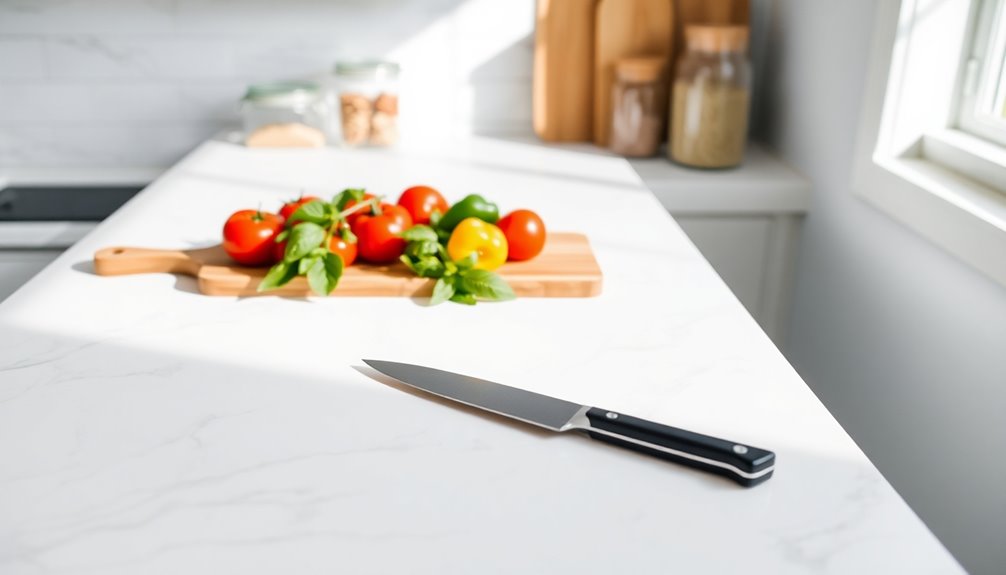Minimalist meal planning simplifies your cooking routine by narrowing your focus to a few staple recipes and whole foods. This approach reduces decision fatigue, saves time, and cuts grocery expenses. By using a master meal list, you can quickly access meal ideas and streamline your grocery shopping. Preparing meals in advance and involving the family in planning fosters healthier eating habits. Discover practical steps to make mealtime enjoyable and efficient as you explore more insights on this topic.
Key Takeaways
- Focus on 10-20 staple meals to streamline meal planning and reduce decision fatigue.
- Organize a master meal list for quick access to favorite recipes and seasonal ingredients.
- Embrace batch cooking for proteins and grains to save time during the week.
- Involve family members in meal planning to accommodate preferences and enhance enjoyment.
- Utilize a focused grocery list to minimize unnecessary purchases and food waste.
Understanding Minimalism in Meal Planning

When you embrace minimalism in meal planning, you're simplifying your food choices to reduce stress and decision fatigue.
You can create a minimalist meal plan by selecting a few staple meals that are quick to make and focus on whole foods. This approach not only fosters familiarity but also makes grocery shopping a breeze.
With a focused list, you minimize unnecessary purchases and food waste, allowing you to concentrate on healthy eating. By prioritizing nourishing ingredients, you make it easier to enjoy meals without the overwhelm of complex recipes. Additionally, incorporating ingredients like celery juice can enhance your diet with its anti-inflammatory properties.
A focused grocery list reduces waste and simplifies healthy eating, allowing you to savor nourishing meals without complexity.
Adopting this mindset helps you appreciate the natural flavors of your food, transforming meal planning into a mindful practice that supports your well-being and lifestyle.
The Benefits of a Minimalist Meal Plan
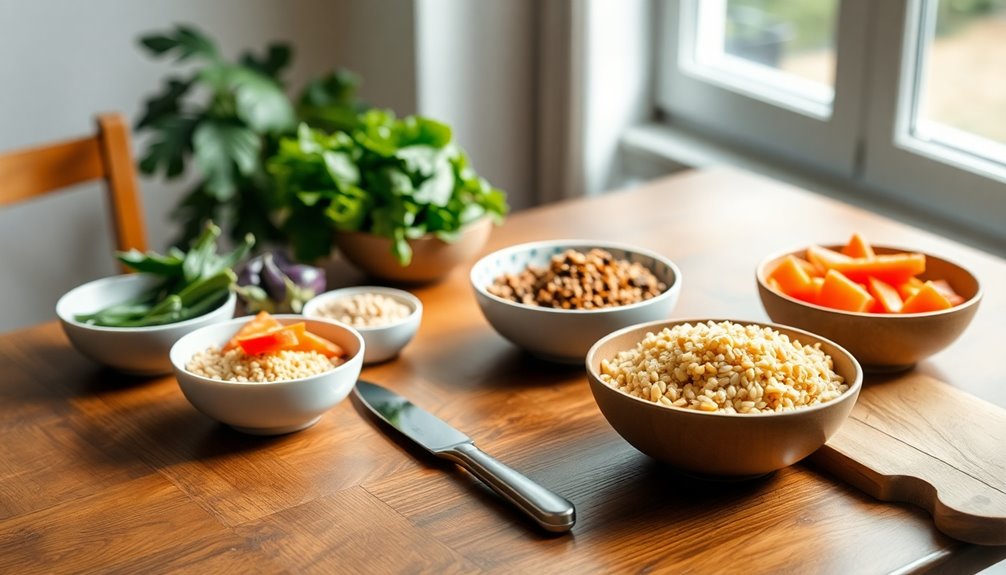
A minimalist meal plan can save you time and money, simplifying your weekly cooking routine.
By sticking to a few favorite recipes and staple ingredients, you'll cut down on grocery expenses and reduce food waste.
This approach not only streamlines meal prep but also allows you to focus on enjoying healthier, more satisfying meals. Incorporating healthy butter substitutes can add diversity to your meals while keeping them nutritious.
Time-Saving Meal Preparation
Minimalist meal planning can save you hours each week by streamlining your cooking process. By focusing on whole foods and quality ingredients, you simplify meal planning, making it easier to create a grocery list that features only what you truly need.
This approach reduces decision fatigue and encourages you to stick to familiar recipes, leading to quicker meal preparation. Preparing meals in advance allows for time-saving assembly during the week, ensuring you have nutritious options ready to go.
Plus, engaging in this minimalist approach fosters enjoyable family meals, as everyone can participate in planning and cooking together. Embracing leftovers creatively also minimizes waste while keeping your meal routine efficient and satisfying. Incorporating high-protein breakfasts can enhance your energy levels and keep you fuller longer throughout the day.
Reduced Grocery Expenses
Streamlining your meal preparation not only saves time but can also lead to significant savings on your grocery bills. By focusing on staple ingredients, you encourage efficient shopping, reducing impulse buys and minimizing food waste.
Planning meals around what you already have helps you avoid unnecessary purchases. Cooking from scratch is often cheaper than buying pre-prepared meals, paving the way for budget-friendly eating.
Additionally, utilizing seasonal produce from local farmers markets can lower your costs while providing fresh options. Engaging in community-supported agriculture (CSA) programs also gives you access to organic produce at a better price. Incorporating homegrown ingredients, such as chia seeds, into your meals can further enhance your nutritional intake while keeping costs down.
Steps to Implement the Minimalist Meal Plan
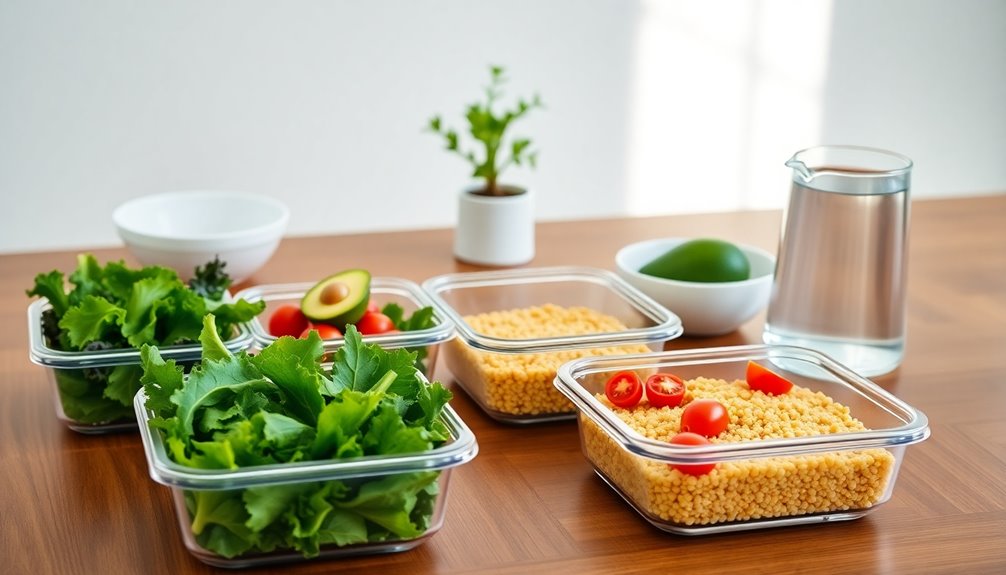
To implement your minimalist meal plan, start by choosing simple recipes that everyone in your family loves.
Next, organize your grocery shopping to guarantee you have all the necessary ingredients on hand.
Finally, regularly evaluate meal preferences to keep things fresh and enjoyable for everyone. Additionally, consider creating a structured environment in your cooking routine to provide stability and reduce decision fatigue.
Choose Simple Recipes
Choosing simple recipes is essential for making your minimalist meal plan work effectively. Start by selecting 10-20 staple meals that your family loves, focusing on whole foods and minimal ingredients. This foundation simplifies meal planning and reduces time in the kitchen. Rotate these simple recipes throughout the week, keeping weekends flexible for new dishes or family favorites. Consistency helps combat decision fatigue, allowing you to enjoy familiar, easy-to-cook meals. Don't forget to incorporate batch cooking strategies for proteins and grains, streamlining your routine even further. Additionally, consider incorporating beetroot into your meals for added nutritional benefits, as it is rich in vitamins and minerals beneficial for growth.
Organize Grocery Shopping
After establishing your go-to simple recipes, the next step involves organizing your grocery shopping to support your minimalist meal plan.
Start by creating a grocery list based on your planned meals for the week, focusing on whole foods to avoid unnecessary purchases. Regularly assess your pantry and fridge contents to guarantee you're using what you already have and to prevent duplicate buys.
Develop a consistent list of staple items to streamline your shopping trips. Schedule these trips for a specific day each week to enhance your planning.
Consider utilizing online grocery services to easily reorder your favorites and save time. This minimalist approach will keep your kitchen stocked and your meal planning efficient. Additionally, regularly vacuuming your kitchen area can help maintain cleanliness and reduce allergens that may affect your cooking environment.
Evaluate Meal Preferences
How can you guarantee your minimalist meal plan aligns with your family's tastes? Start by evaluating your meal preferences.
Brainstorm and list 10-20 of your family's favorite meals to create a strong base for your weekly meal plan. Focus on dinner options, but feel free to add breakfast and lunch ideas.
Here's how to get started:
- Categorize meals by type: pastas, soups, stir-fries, etc.
- Include fresh vegetables to keep meals healthy.
- Regularly review and update your master meal list to reflect evolving tastes.
- Utilize a digital format for easy access and streamlined planning. Additionally, consider incorporating air fryer recipes for healthier cooking options that your family will love.
This simple meal planning approach guarantees your recipes resonate with your family and reduces decision fatigue during cooking and grocery shopping.
Creating Your Master Meal List
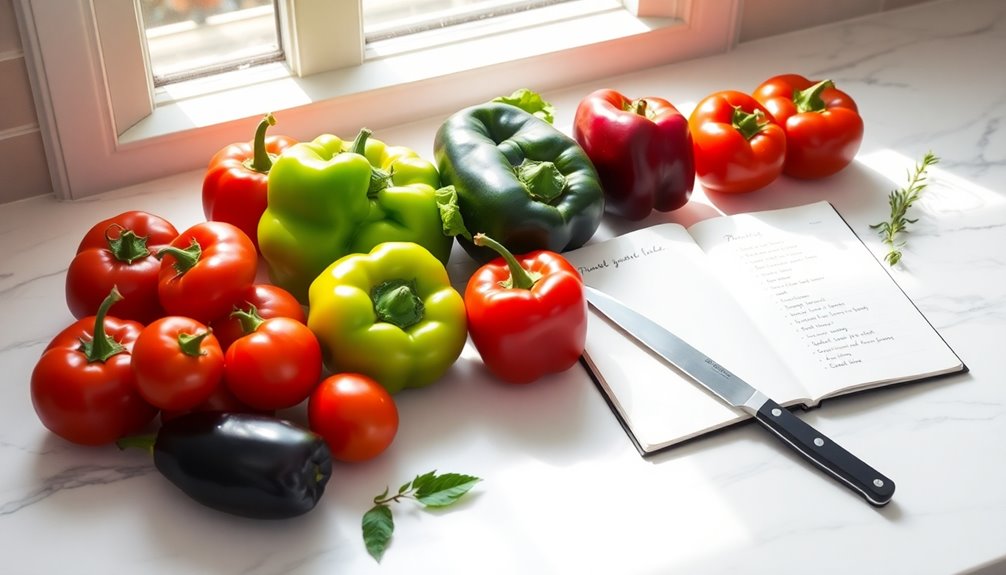
Creating a master meal list can transform your weekly cooking routine, making it easier and more enjoyable. Start by brainstorming 10-20 of your favorite dinner recipes that keep it simple with real food.
This master meal list will streamline meal planning and help reduce decision fatigue for your busy family. Don't forget to include a section for breakfast and lunch ideas as desired.
Organize your list digitally for easy access and link to recipes, allowing you to modify meals seasonally for variety. Regularly updating your master meal list can enhance your cooking confidence, making meal options feel fresh and exciting. Additionally, implementing feedback mechanisms can help refine your meal planning process over time.
Embrace this approach, and you'll find meal planning becomes a breeze!
Organizing and Utilizing Your Meal Plan
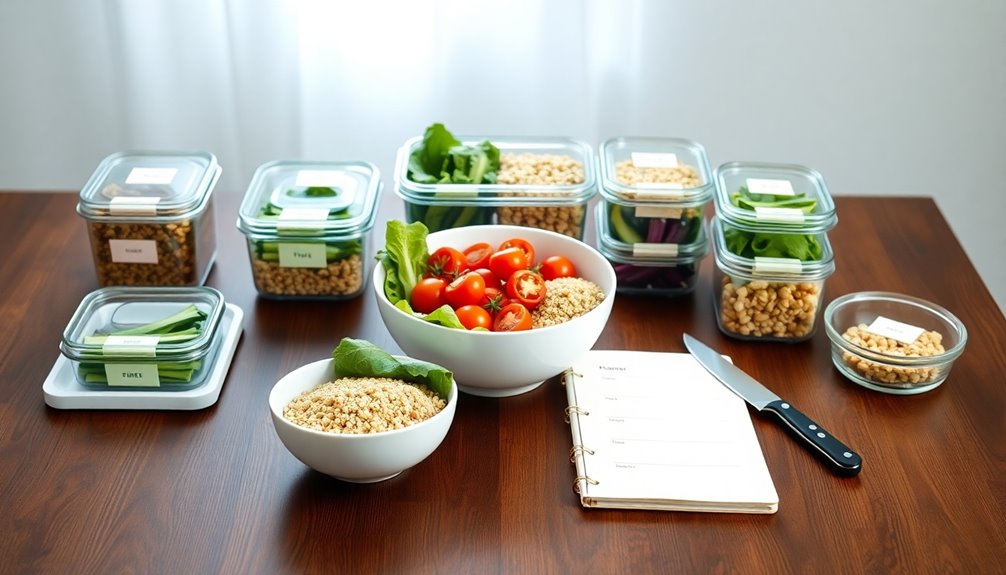
- Create a master meal list with 10-20 familiar meals for quick access.
- Organize your list digitally to link directly to recipes and seasonal ingredients.
- Reuse meal plans regularly to minimize planning time and maintain consistency.
- Incorporate space for new recipes to explore while keeping familiar meals front and center. Additionally, consider using compact kitchen appliances to enhance efficiency and ease in your cooking routine.
Strategies for Simplifying Meals
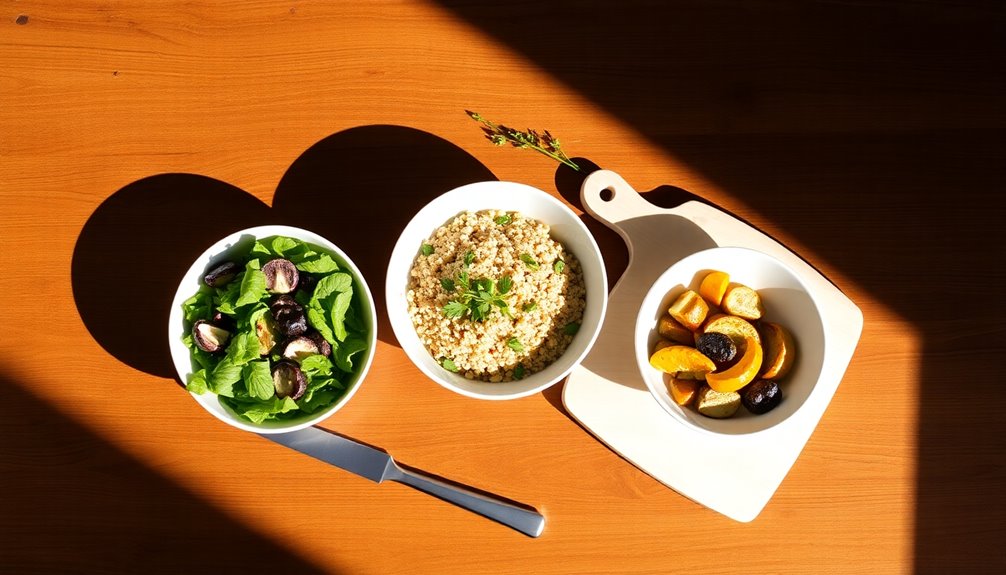
While juggling a busy schedule, you can simplify your meals by focusing on versatile ingredients and streamlined recipes.
Start by creating a list of staple foods, like grains, beans, and seasonal produce, that can serve as the base for multiple meals. Limit yourself to 10-20 family favorites to reduce decision fatigue.
Pre-chop veggies and proteins in advance to save time during the week. Embrace simple recipes, like buddha bowls or platter meals, that allow for quick assembly and creativity without extensive cooking.
Don't forget to make use of leftovers for easy lunches or dinners. By adapting your meal plan based on seasonal food and your young kids' preferences, you'll streamline your cooking routine and enjoy more time together.
Overcoming Common Meal Planning Challenges
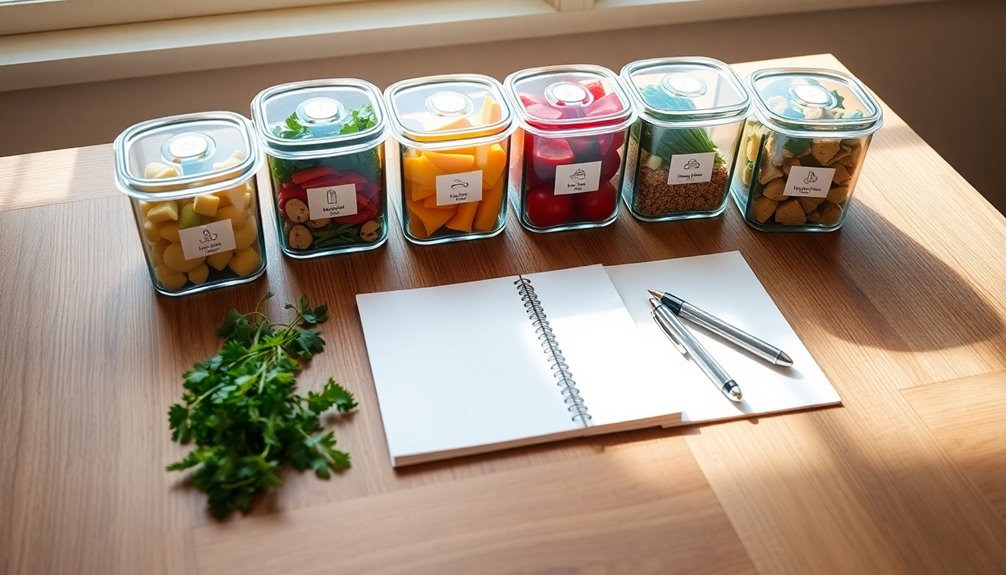
Meal planning can feel overwhelming, especially when daily life throws unexpected challenges your way. To simplify your routine and save time, try these strategies:
- Create a meal list: Compile 10-20 family favorites to streamline options and reduce decision fatigue.
- Utilize a capsule pantry: Stock versatile ingredients that make quick meal assembly easy and simplify grocery shopping.
- Involve family members: Get everyone's input to accommodate different dietary preferences and share the planning load.
- Stay flexible: Adjust your meals based on mood or weather to keep cooking enjoyable and stress-free.
Community Insights and Personal Experiences

How can a community transform your meal planning experience? Engaging with others can make your cooking easier and more enjoyable.
Many families report positive changes in their meal routines and reduced grocery expenses by adopting minimalist meal planning. You might find that involving your kids fosters their interest in healthy eating, making mealtimes a family affair.
A master meal list can alleviate decision fatigue, allowing you to focus on whole foods and beloved recipes, while ensuring you have leftovers for lunch. Plus, sharing personal journeys within a supportive community helps inspire healthier eating habits and reduces food waste.
Ultimately, you'll experience less stress and more satisfaction as you streamline your grocery run per week.
Embracing Flexibility in Your Cooking Routine
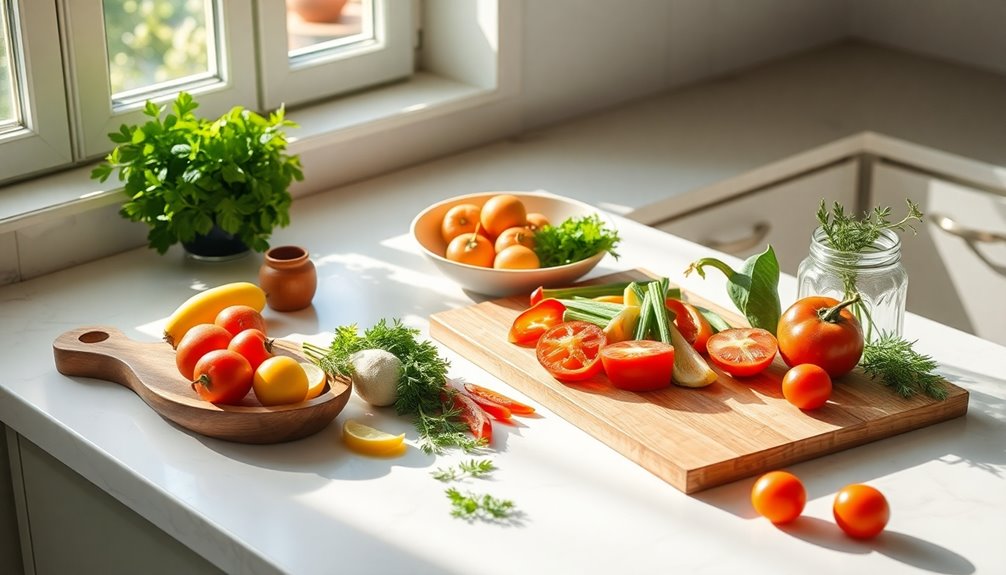
Flexibility is the key ingredient to a stress-free cooking routine. When you embrace it, you can easily adjust your meals based on your daily schedule and mood.
Here are some ways to incorporate flexibility into your cooking:
- Know your staples: Keep a few go-to meals you love to simplify weeknight dinners.
- Use leftovers creatively: Repurpose them for new dishes to minimize waste and maximize flavor.
- Plan meals with seasonal ingredients: This adds variety and freshness, inspiring new recipe ideas.
- Encourage family input: Involve everyone in meal selection, making cooking and eating more enjoyable.
With these strategies, you'll not only enjoy eating more but also foster a collaborative kitchen environment.
Embrace flexibility and transform your cooking routine!
Frequently Asked Questions
What Is the 5 5 5 Meal Plan?
The 5 5 5 Meal Plan is a straightforward approach to meal planning that focuses on preparing five main meals with just five ingredients each.
This method simplifies your grocery shopping and meal prep, cutting down on decision fatigue. You can easily mix and match ingredients, promoting healthier eating habits while keeping it fun.
Plus, it's flexible enough to adapt to your dietary preferences or seasonal produce, making cooking enjoyable and less time-consuming.
How to Simplify Meal Planning?
To simplify meal planning, start by creating a Master Meal List of your favorite recipes. This reduces decision fatigue and helps you focus on what your family loves.
Organize your grocery shopping around whole foods to cut down on waste and save money. Use a basic meal planning template and prep versatile ingredients in advance.
Finally, think creatively about leftovers to make the most of what you have and minimize waste.
What Are the 5 Principles of Meal Planning?
Imagine a bustling kitchen filled with the aroma of your favorite dishes.
To master meal planning, focus on these five principles: prioritize familiar meals that spark joy, create a detailed grocery list to avoid waste, prep ingredients ahead for quick access, stay flexible to adapt to cravings or schedules, and involve your family in the process to guarantee everyone enjoys the meals.
This way, cooking becomes a delightful experience rather than a chore.
What Is the Rule of 3 Meal Plan?
The Rule of 3 Meal Plan is a simple and effective way to streamline your weekly meals. You select three main meals for each day, balancing protein, vegetables, and grains to guarantee variety.
This method reduces decision fatigue and makes grocery shopping easier by limiting your ingredient list. Plus, it promotes less food waste by accommodating leftovers.
Conclusion
In the grand tapestry of your kitchen, embracing minimalist meal planning can be your guiding star, much like Odysseus steering the seas. By simplifying your cooking routine, you're not just saving time; you're reclaiming joy in the process. Remember, it's not about perfection but finding balance and ease in your meals. So, sail forth with confidence, knowing that less truly can be more, and every delicious bite brings you closer to culinary freedom.
